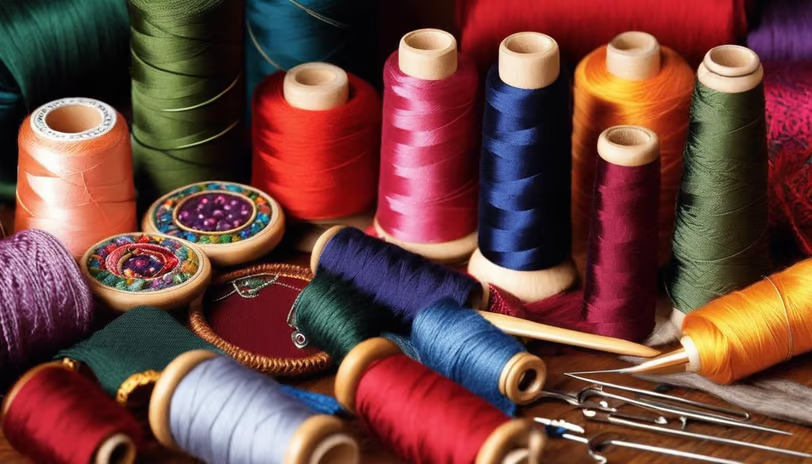In the world of crafts, needlework holds a distinctive niche, encompassing an array of activities such as embroidery, knitting, and crochet. These cherished traditional arts not only serve as anecdotal vehicles for cultures across the globe, but also provide a therapeutic source of personal fulfillment. Whether you are an avid DIY enthusiast or a beginner stepping into the creative realm, understanding needlework basics can unravel a plethora of possibilities. From familiarizing yourself with the types of needlework, mastering different stitches in embroidery, knitting, and crochet, to learning about appropriate tools and their care, every chunk of knowledge reflects a stroke in the canvas of your creation.
Understanding Needlework Basics
Magic and Mettle-Understanding the Basics of Needlework
In the vast expanse of art and creation, needlework graces a unique position, as numerous creative souls find it both therapeutic and liberating. The path to mastering needlework is punctuated with the joy of expression, artistic fulfillment, and a beautiful product in the end. Join us on a journey to unravel these fundamental threads!
Step 1: Know your tools
A fundamental part of needlework involves familiarizing yourself with the tools. Notably, there are four key ones: the needle, thread, thimble, and the hoop. Each plays a unique role; the needle pierces the fabric, the thread intertwines to form patterns, the thimble guards your fingers, and the hoop stretches the fabric for neater work. Understanding how these items function individually and together paints the first stroke on your needlework canvas.
Step 2: Dive into the Fabric Universe
The world of fabrics is a sea of attributes; fiber types, weave patterns, and thread count – all significantly impact your end result. For beginners, it’s recommended to start with an even-weave fabric, which is fantastic for establishing continuity and uniformity in stitch lines. As your confidence grows, you might explore other complex fabrics to enhance your artistic expression.
Step 3: Grasp the Stitches
At the heart of needlework lie stitches, each carrying a unique personality. The running stitch, the backstitch, and the cross-stitch are generally viewed as the primary types that form the foundation of this craft. Their varied texture and depth offer a rich well of artistic possibilities. Embarking on understanding and mastering these stitches is akin to learning the musical scales on your road to composing a symphony.
Step 4: Patterns: The Rhythm of Needlework
Another pillar of needlework artistry is the ability to read and follow patterns. Pattern reading is an indispensable skill that enables visualizing the final product and planning your needle’s journey across the fabric. Initially, you might want to practice with simple patterns, and then progress towards multi-colored, dense, and intricate ones, elevating your needlework virtuosity to new heights.
Step 5: Cultivate Patience and Love For the Process
Though this might seem abstract, any artist would nod in agreement that it’s necessary. Needlework is an art of patience; the intricate details take time and precision. It is also an act of love, for your hands craft
each stitch while your creative spirit breathes life into the fabric. Embracing the process – the hardships, the joys, the mastery, and the learning – is what sets your art apart and enraptures onlookers.
So, set sail on your creative journey, filled with colorful threads, rhythmic patterns, and the satisfaction of seeing a blank canvas turn into a masterpiece. Remember, every great artist began with a single stitch and a leap into the unknown.
Initiating Embroidery Projects
Embarking on an Embroidery Journey: Discovery, Focus, Creation
Embroidery can come to life in many forms, each as unique as the hands that craft the work. It is in the process of creation where beauty and enjoyment are found, blossoming from the meeting point of needle and thread. With a strong understanding of needlework tools, fabrics, and stitches, the next step on your artistic adventure emerges: starting an embroidery project.
First, profound creativity comes by way of inspiration. Look around you. Turn the pages of an art book. Gaze at the natural world or take insights from the laughter of a child. Sources of inspiration are innumerable and are deeply personal as well. What speaks to you may not speak to your neighbor. Immerse yourself in these ideas and let your mind wander in the creative wilderness. As your spirits are kindled, sketch onto paper the design you wish to capture in thread. Draw out your ideas and explore what makes your imagination leap.
After the ideation phase, comes the crucial step of transferring your envisioned design onto the canvas. Equal parts art and science, this intricate dance forms the pathway that your needle will follow. You can make use of a dis-soluble marker or carbon paper for transferring your design. The shadows and lines traced onto the fabric will guide your every stroke, making this step pivotally important.
Once the design is on the fabric, you hoist your sails and embark on your embroidery voyage. Adorning the fabric-covered hoop in your left hand and armed with a threaded needle in your right, you commence stitching, following the sequence of one, two, or maybe even three types of stitches you’ve mastered. Let your needle glide gently in and out of the fabric, paying close attention to maintaining consistent tension. Too tight, and your fabric puckers, too loose, and your threads could tangle.
With every thread pulled and every stitch made, an image begins to form. Each stitch a note, it sings on the fabric, creating a symphony of colors and textures. It’s a labor of love, each moment spent stitching adding depth, character, and intricate detail to the design. This is the heart of embroidery – the careful, meticulous work that transforms an image into a textured artwork.
Finally, as you near the completion of your piece, the moment arrives for one last, important task: washing and ironing the
cite, creating a pristine rendering of your creative vision. Just a delicate wash and a gentle press, preserving each precious stitch while smoothing any wrinkles or creases in the fabric.
Embroidery is more than merely a craft. It’s a journey, a testimony to patience and skill. It’s an art, inviting you to find satisfaction not just in the final masterpiece, but in every inspired thought, every sketched line, and every crafted stitch along the way.
Mastering Knitting and Crochet
Diving into the Heart of Needlework: The Delicate Dance of Knitting and Crochet
Embarking on the journey of needlework is much like a waltz; it begins slowly, gently and then blossoms into intricate movements that demand finesse, understanding, and nimble dexterity. It’s akin to a dance between fingers as they weave stories in yarn, culminating into a beautiful symphony of knitting and crochet. However, when deep-diving into the world of knitting and crochet, it is essential to familiarize oneself with the unique complexities inherent to these art forms.
Firstly, identifying the appropriate materials – the yarn types and focused tools – form the backbone of knitting and crochet creations. The yarn’s fiber components – cotton, acrylic, wool, or a blend, will inevitably foretell the texture, feel, durability, and care instructions of the handmade item. Similarly, the knitting needles and crochet hooks used play a crucial role in determining the size and style of stitches in the completed work.
Secondly, matters often overlooked but tightly knitted into the fabric of these practices are the techniques and styles – English or Continental in knitting and Tunisian or Filet in crochet. These styles serve not just as mediums but as a testament to the diverse culture and history of such an art form that echo worldwide. They each create specific effects and patterns, dictated by their rhythmic motions. Becoming fluent in these techniques can open doorways to an array of unique and breathtaking designs.
Thirdly, it’s all about the unseen hero of any knitting or crochet project: tension control. Similar to the tightrope a dancer tip-toes on during a performance, maintaining consistency in yarn tension results in a fluid and even creation. Too tight, and the fabric becomes stiff; too loose, and the design lacks structure, leading to inconsistencies in size and appearance.
Lastly, propelled forward by imagination alone, designer patterns form the invisible blueprint to needles and threads’ grand ballet. These patterns are the guiding star to any knitting or crochet project, sparking ideas that evolve into tangible works of art. Mastering the language of pattern-reading – understanding the symbols, charts, and terminology – bridges the gap between dreaming and creation.
To spin a metaphor, if embroidery exists as a carefully crafted sonnet, then knitting and crochet would be the limerically free-flowing prose of the textile poetry realm. Recognizing the intricate tapestry interwoven within these complexities allows one to delve deeper into the passion-filled journey of knitting and crochet, ultimately allowing the dance of needlework to truly leap off the page and into the hands of the creator.
In essence, knitting and crochet is a labyrinth of complexities, each turn introducing unique nuances and demands. Here lies an art form that tugs at the very threads of creativity, dexterity, and patience, all the while rewarding you with a dance between fingers – a dance that tells stories, keeps warm, and gives life to craftsmanship in the purest form.
Spanning from the subtleties of drafting an embroidery design, threading the needle, crafting each stitch with precision, to the intricate process of developing a knitting or crochet project, this needlework journey extends an opportunity to explore and refine your creative aptitudes. As you delve deeper into learning the myriad of patterns and techniques, the growing comprehension and proficiency will offer phenomenal satisfaction, broadening the horizon of your abilities. So, seize the needle and thread, embark on your needlework adventure, and watch in awe as you turn basic thread into remarkable textile art.









